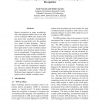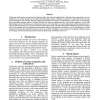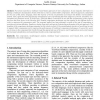26 search results - page 4 / 6 » Modeling Morphologically Rich Languages Using Split Words an... |
LREC
2010
13 years 6 months ago
2010
This paper investigates the mapping between two semantic formalisms, namely the tectogrammatical layer of the Prague Dependency Treebank 2.0 (PDT) and (Robust) Minimal Recursion S...
ACL
2007
13 years 6 months ago
2007
Speech recognition in many morphologically rich languages suffers from a very high out-of-vocabulary (OOV) ratio. Earlier work has shown that vocabulary decomposition methods can ...
CLEF
2008
Springer
13 years 6 months ago
2008
Springer
Many modern natural language processing applications would benefit from automatic morphological analysis of words, especially when dealing with morphologically rich languages. Con...
LREC
2010
13 years 6 months ago
2010
Without any doubt corpora are vital tools for linguistic studies and solution for applied tasks. Although corpora opportunities are very useful, there is a need of another kind of...
IAJIT
2011
12 years 11 months ago
2011
: This article describes a multilayer model-based approach for text compression. It uses linguistic information to develop a multilayer decomposition model of the text in order to ...



